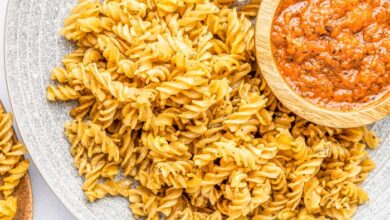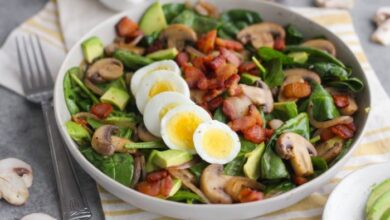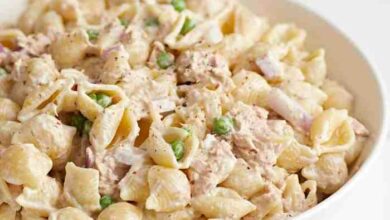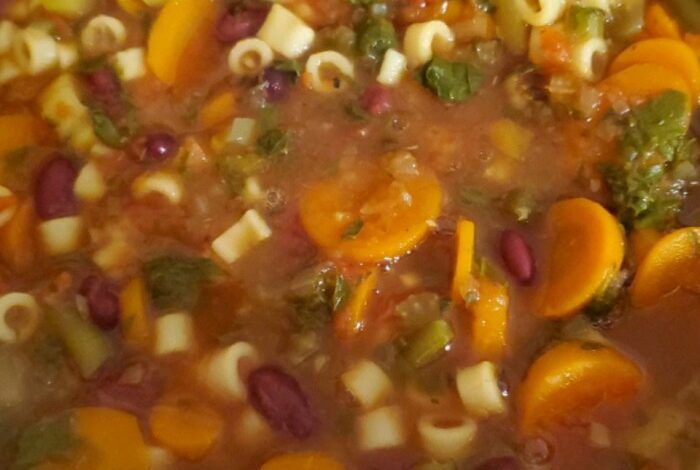
Slow Cooker Vegetarian Minestrone: A Hearty and Healthy Meal
Slow cooker vegetarian minestrone takes center stage, inviting you to a world of flavor and nourishment. This classic Italian soup, simmered to perfection in your slow cooker, offers a comforting and satisfying meal that’s both delicious and good for you.
With its origins tracing back to centuries-old Italian peasant cuisine, minestrone has evolved into a beloved dish celebrated for its versatility and ability to showcase the bounty of fresh vegetables.
This hearty soup is a true embodiment of the slow food movement, allowing the flavors of the ingredients to meld and deepen as they gently cook. It’s also a fantastic way to use up leftover vegetables and create a meal that’s both budget-friendly and bursting with nutrients.
Whether you’re a seasoned cook or a beginner in the kitchen, slow cooker vegetarian minestrone is a recipe that’s sure to become a staple in your repertoire.
Introduction
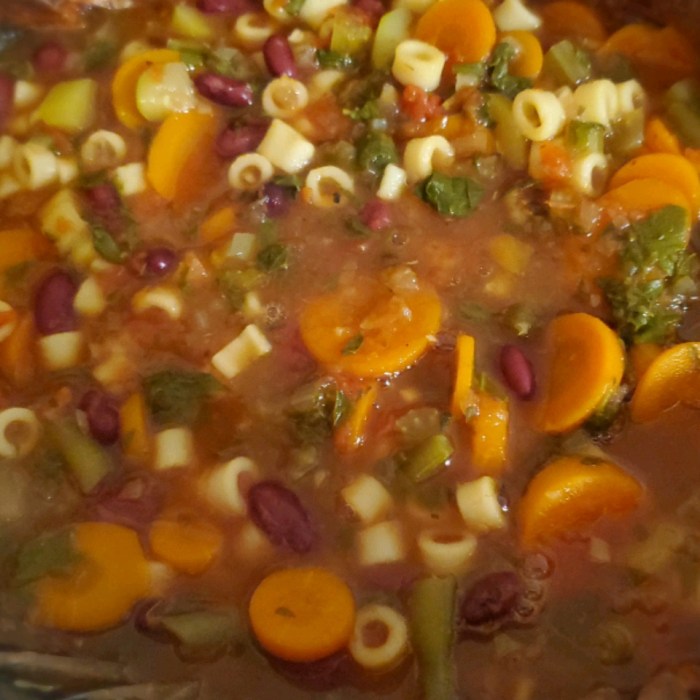
Imagine a steaming bowl of hearty, flavorful soup, bursting with fresh vegetables and aromatic herbs, simmered to perfection in a slow cooker. This is the magic of vegetarian minestrone, a classic Italian soup that embodies the essence of comfort food.
It’s a dish that’s both nourishing and satisfying, perfect for a chilly evening or a light lunch.Minestrone has a rich history, dating back centuries in Italy. It was traditionally prepared by peasant families who used whatever vegetables were in season, creating a humble yet flavorful dish.
Over time, minestrone evolved into a culinary staple, enjoyed by people of all ages and backgrounds.
Health Benefits
Vegetarian minestrone is a nutritional powerhouse, packed with vitamins, minerals, and fiber. The abundance of vegetables provides essential nutrients, while the broth offers hydration and electrolytes. This soup is an excellent source of:
- Antioxidants:The colorful vegetables in minestrone, such as tomatoes, carrots, and spinach, are rich in antioxidants, which protect cells from damage caused by free radicals.
- Fiber:Fiber promotes digestive health, helps regulate blood sugar levels, and can aid in weight management.
- Vitamins and Minerals:Minestrone is a good source of vitamins A, C, and K, as well as minerals like potassium and iron.
“A single serving of vegetarian minestrone can provide a significant portion of your daily recommended intake of vitamins and minerals.”
Recipe Variations
The slow cooker method is a true game-changer for minestrone, allowing for hands-off cooking and deeply flavorful results. The long, slow simmering process melds the ingredients beautifully, creating a rich and satisfying broth.
Key Ingredients for Flavorful Vegetarian Minestrone
The key to a truly delicious vegetarian minestrone lies in the carefully chosen ingredients that contribute to a complex and satisfying flavor profile.
- Vegetables:A variety of vegetables are essential for a well-rounded minestrone. Consider using a combination of root vegetables (carrots, potatoes, celery), leafy greens (kale, spinach, chard), and beans (cannellini, kidney, borlotti). Each vegetable adds its own unique flavor and texture, contributing to the overall richness of the soup.
- Broth:A flavorful vegetable broth forms the base of the soup, providing the foundation for the other ingredients to shine. Opt for a high-quality broth made with fresh vegetables and herbs for the best results.
- Herbs and Spices:A blend of herbs and spices elevates the minestrone to new heights. Classic additions include fresh basil, oregano, thyme, rosemary, and bay leaves. You can also experiment with other herbs and spices like garlic, onion, and pepper for added depth of flavor.
Slow cooker vegetarian minestrone is a real crowd-pleaser, especially on chilly evenings. It’s hearty, flavorful, and perfect for those nights when you don’t want to spend a lot of time in the kitchen. If you’re looking for a lighter option to accompany your minestrone, you might want to try this simple crustless spinach and mushroom quiche.
It’s packed with nutrients and surprisingly easy to make. And just like the minestrone, it’s a great way to use up leftover veggies!
- Pasta:Pasta adds heartiness and texture to the soup. Choose small pasta shapes like ditalini, orzo, or stelline, which cook quickly and absorb the flavorful broth beautifully.
- Tomato Paste:A touch of tomato paste adds richness and depth to the soup. It also helps to thicken the broth, creating a more satisfying consistency.
Minestrone Recipe Variations, Slow cooker vegetarian minestrone
Here are some variations on the classic vegetarian minestrone recipe, highlighting different flavor profiles and serving suggestions:
| Recipe Name | Key Ingredients | Flavor Profile | Serving Suggestions |
|---|---|---|---|
| Classic Minestrone | Carrots, potatoes, celery, onions, garlic, kale, cannellini beans, vegetable broth, tomato paste, basil, oregano, thyme, ditalini pasta | Earthy, savory, with a hint of sweetness | Enjoy hot with a crusty bread for dipping. |
| Mediterranean Minestrone | Carrots, zucchini, bell peppers, spinach, chickpeas, vegetable broth, tomato paste, fresh basil, oregano, lemon juice, ditalini pasta | Bright, citrusy, with a Mediterranean flair | Serve with a drizzle of olive oil and a sprinkle of feta cheese. |
| Spicy Minestrone | Carrots, potatoes, celery, onions, garlic, kale, kidney beans, vegetable broth, tomato paste, chili flakes, cumin, coriander, orzo pasta | Spicy, earthy, with a warm kick | Top with a dollop of sour cream or yogurt for a creamy contrast. |
| Tuscan Minestrone | Carrots, potatoes, celery, onions, garlic, spinach, borlotti beans, vegetable broth, tomato paste, fresh rosemary, sage, Parmesan cheese, ditalini pasta | Rich, savory, with a hint of earthiness | Serve with a generous sprinkle of Parmesan cheese and a side of crusty bread. |
Cooking Techniques: Slow Cooker Vegetarian Minestrone
The beauty of minestrone lies in its adaptability. You can customize it with your favorite vegetables, beans, and pasta. While you can definitely make this soup on the stovetop, using a slow cooker brings a unique depth of flavor and allows for hands-off cooking.
Slow Cooker Preparation
The slow cooker simplifies the minestrone-making process. Here’s a step-by-step guide:
- Sautéing the aromatics: Start by sautéing onions, garlic, and celery in a pan with olive oil. This step enhances the flavor profile of the soup.
- Adding vegetables: Add diced vegetables, such as carrots, zucchini, potatoes, and tomatoes, to the slow cooker. The slow cooker will gently cook these vegetables until tender.
- Incorporating beans and broth: Pour in your chosen broth, such as vegetable or chicken broth, along with canned beans, like kidney beans or cannellini beans.
- Simmering and flavoring: Cover the slow cooker and cook on low heat for 6-8 hours, or on high heat for 3-4 hours. This allows the flavors to meld and the vegetables to soften. Season with salt, pepper, and herbs like basil or oregano.
- Adding pasta: About 30 minutes before serving, add your preferred pasta, such as ditalini or small elbow macaroni. This ensures the pasta cooks through without becoming mushy.
Ingredient Preparation and Timing
Proper ingredient preparation is crucial for a flavorful and well-textured minestrone.
- Chopping vegetables: Dice vegetables into even-sized pieces to ensure they cook evenly. Smaller pieces cook faster, while larger pieces may require longer cooking times.
- Using canned beans: Canned beans are a convenient option, but rinsing them before adding them to the slow cooker removes excess sodium and helps prevent the soup from becoming overly salty.
- Timing pasta addition: Adding pasta towards the end of the cooking process ensures it cooks through without becoming overcooked.
Cooking Process
The slow cooker allows for a hands-off approach, but there are a few key steps to ensure a delicious minestrone.
- Sautéing: Sautéing the aromatics (onions, garlic, celery) before adding them to the slow cooker intensifies their flavor and adds depth to the soup.
- Simmering: The slow cooker gently simmers the ingredients, allowing the flavors to meld and the vegetables to soften.
- Adjusting consistency: As the soup simmers, you can adjust the consistency by adding more broth or letting it simmer longer to reduce the liquid.
Achieving the Perfect Consistency
The perfect minestrone should have a balance of flavors and textures.
- Soup thickness: The soup should be thick enough to coat the spoon but not so thick that it’s difficult to eat.
- Vegetable tenderness: The vegetables should be tender but not mushy.
- Pasta texture: The pasta should be cooked through but still have some bite.
Serving and Enjoyment
A steaming bowl of vegetarian minestrone is a delightful experience, especially when served with the right accompaniments and presentation. Let’s explore the best ways to savor this hearty and flavorful soup.
Serving Temperature and Garnishes
Serving temperature plays a crucial role in enhancing the taste and texture of the minestrone. It’s best enjoyed piping hot, allowing the flavors to fully develop and the vegetables to retain their optimal texture. A sprinkle of freshly grated Parmesan cheese adds a savory touch and a burst of umami, while a drizzle of olive oil adds richness and depth.
A sprig of fresh basil or parsley provides a vibrant pop of color and a refreshing aroma, completing the presentation.
Storing and Reheating Leftovers
Leftovers can be stored in an airtight container in the refrigerator for up to 3-4 days. To reheat, simply place the minestrone in a saucepan over medium heat and bring to a simmer, stirring occasionally. Alternatively, you can reheat individual portions in the microwave for about 1-2 minutes.
Avoid overcooking, as this can make the vegetables mushy.
Ways to Enjoy Vegetarian Minestrone
| Serving Occasion | Accompanying Dishes | Beverage Pairings | Presentation Ideas |
|---|---|---|---|
| Casual Weeknight Dinner | Grilled cheese sandwich, crusty bread | Red wine, sparkling water | Served in rustic bowls with a dollop of sour cream or yogurt |
| Formal Dinner Party | Roasted vegetables, salad with vinaigrette dressing | Dry white wine, light beer | Presented in elegant soup bowls with a sprinkle of herbs and a drizzle of balsamic glaze |
| Potluck | Assortment of breads, crackers, cheeses | Fruit juice, iced tea | Served in a large crockpot with garnishes and toppings on the side |
| Lunchbox | Sandwich, fruit salad | Water, milk | Packed in a thermos to keep warm, with a side of crusty bread |
Nutritional Considerations
A vegetarian minestrone is a nutritional powerhouse, brimming with essential vitamins, minerals, and antioxidants. This hearty soup offers a balanced and satisfying meal, providing numerous health benefits.
Key Nutrients and Benefits
The ingredients in a vegetarian minestrone contribute a diverse array of essential nutrients. Here’s a breakdown of the key vitamins, minerals, and antioxidants present:
- Vitamins:
- Vitamin A:Found in carrots, tomatoes, and spinach, vitamin A supports healthy vision, skin, and immune function.
- Vitamin C:Rich in tomatoes, peppers, and kale, vitamin C is an antioxidant that boosts immunity and collagen production.
- Vitamin K:Leafy greens like spinach and kale are excellent sources of vitamin K, crucial for blood clotting and bone health.
- B Vitamins:Beans, lentils, and whole grains contribute to a range of B vitamins, essential for energy production, cell growth, and nervous system function.
- Minerals:
- Potassium:Tomatoes, beans, and lentils provide potassium, which helps regulate blood pressure and muscle function.
- Iron:Beans, lentils, and spinach are good sources of iron, essential for oxygen transport and red blood cell production.
- Magnesium:Leafy greens, beans, and lentils contribute magnesium, which supports muscle and nerve function, blood sugar control, and blood pressure regulation.
- Calcium:While not as rich as dairy products, vegetables like kale and bok choy offer some calcium, vital for bone health.
- Antioxidants:
- Lycopene:Found in tomatoes, lycopene is a powerful antioxidant linked to reduced risk of heart disease and certain cancers.
- Lutein and Zeaxanthin:Leafy greens like spinach and kale are rich in these antioxidants, which protect eye health.
- Flavonoids:Many vegetables and herbs in minestrone, such as onions, garlic, and parsley, contain flavonoids with anti-inflammatory properties.
Slow Cooker Method and Nutrient Preservation
The slow cooker method is particularly beneficial for preserving the nutritional value of ingredients. Unlike high-heat cooking methods that can degrade vitamins and antioxidants, slow cooking allows ingredients to simmer gently in their own juices, retaining their nutrients. This method also minimizes water loss, preserving valuable minerals.
Comparison with Other Soup Options
Compared to other soup options, vegetarian minestrone stands out as a nutrient-rich and fiber-packed choice. For example, while a creamy tomato soup might be delicious, it typically lacks the fiber and diverse range of vitamins and minerals found in minestrone.
Similarly, a simple chicken noodle soup, while comforting, may not offer the same level of antioxidants and plant-based nutrients.



